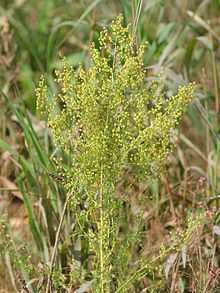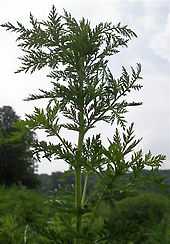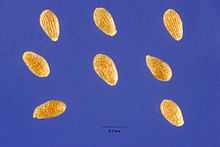Artemisia annua
| Artemisia annua | |
|---|---|
 | |
| Scientific classification | |
| Kingdom: | Plantae |
| (unranked): | Angiosperms |
| (unranked): | Eudicots |
| (unranked): | Asterids |
| Order: | Asterales |
| Family: | Asteraceae |
| Genus: | Artemisia |
| Species: | A. annua |
| Binomial name | |
| Artemisia annua L. | |
Artemisia annua, also known as sweet wormwood, sweet annie, sweet sagewort, annual mugwort[1] or annual wormwood (Chinese: 青蒿; pinyin: qīnghāo), is a common type of wormwood native to temperate Asia, but naturalized throughout the world.
Characteristics
It has fern-like leaves, bright yellow flowers, and a camphor-like scent. Its height averages about 2 m, and the plant has a single stem, alternating branches, and alternating leaves which range from 2.5–5 cm in length. It is cross-pollinated by wind or insects. It is a diploid plant with chromosome number 2n=18.[2][3]
Medicinal uses
Folk medicine
In traditional Chinese medicine, A. annua is traditionally used to treat fever.[4]
Extractions
In 1971, scientists demonstrated the plant extracts had antimalarial activity in primate models, and in 1972, the active ingredient, artemisinin (formerly referred to as arteannuin), was isolated and its chemical structure described. Artemisinin may be extracted using a low boiling point solvent, such as diethylether, and is found in the glandular trichomes of the leaves, stems, and inflorescences, and it is concentrated in the upper portions of plant within new growth.[5]
Malaria treatment

Research to develop antimalarial drugs led to the discovery of artemisinin, which is extracted from Artemisia annua, a herb traditionally used as a fever treatment.[4][6] While most TCM herbs are boiled at high temperature that can damage the active ingredient in Artemisia annua,[6] one traditional source says that this herb is to be steeped in cold water;[7] knowing this, scientists found that a better extract was obtained by using a low-temperature ether-based extraction method, and by adding detoxification and purification processes, they could create a drug with sufficient active ingredient to be effective.[6]
Artemisinin is a sesquiterpene lactone with an endoperoxide bridge and has been produced semisynthetically as an antimalarial drug. The efficacy of tea made from A. annua in the treatment of malaria is contentious. According to some authors, artemesinin is not soluble in water and the concentrations in these infusions are considered insufficient to treat malaria.[8][9][10] In 2004, the Ethiopian Ministry of Health changed Ethiopia's first line antimalaria drug from sulfadoxine/pyrimethamine (Fansidar), which has an average 36% treatment failure rate, to artemether/lumefantrine (Coartem), a drug therapy containing artemesinin which is 100% effective when used correctly, despite a worldwide shortage at the time of the needed derivative from A. annua.[11] A 2012 review said that artemisinin-based remedies are the most effective drugs for the treatment of malaria.[12] A 2013 review suggested that although Artemisia annua may not cause hepatotoxicity, haematotoxicity, or hyperlipidemia, it should be used cautiously during pregnancy due to a potential risk of embryotoxicity at a high dose.[13]
Despite global efforts in combating malaria, it remains a large burden for the population, particularly in tropical and subtropical regions.[14] Although WHO recommends artemisinin-based remedies for treating uncomplicated malaria, artemisinin resistance can no longer be ignored.[14] The causes that affected the emergence of artemisinin resistance include, for example, the use of artemisinin-based remedies.[14] Encouraging herbal alternatives are in the pipeline, but the only indelible solution for the eradication of malaria would be for the creation of an effective vaccination.[14] Emergence of artemisinin resistance has been identified in Cambodia and the border of Thailand.[15] It will likely spread to other endemic areas across the world in the impending future.[15] As of 2013, it seems that the pathogenic agent of malaria is slowly becoming resistant to artemisinin-based drugs.[16][17]
Asthma
Animal experiments showed that artesunate, a synthetic derivative of artemisinin, has anti-allergic properties, by effecting mast cell degranulation. This makes artesunate a candidate for treatment of allergic asthma.[18] A Metabolomics animal study further strengthens this hope.[19]
Mechanism

The proposed mechanism of action of artemisinin involves cleavage of endoperoxide bridges by iron, producing free radicals (hypervalent iron-oxo species, epoxides, aldehydes, and dicarbonyl compounds) which damage biological macromolecules causing oxidative stress in the cells of the parasite.[20] Malaria is caused by apicomplexans, primarily Plasmodium falciparum, which largely reside in red blood cells and itself contains iron-rich heme-groups (in the form of hemozoin).[21]
Cancer drug research
Synthetic derivatives of artemisinin are being investigated for their potential use as anticancer drugs.[22]
References
- ↑ "BSBI List 2007" (xls). Botanical Society of Britain and Ireland. Retrieved 2014-10-17.
- ↑ Kreitschitz, A.; J. Vallès (September 2003). "New or rare data on chromosome numbers in several taxa of the genus Artemisia (Asteraceae) in Poland". Folia Geobotanica 38 (3): 333–343. doi:10.1007/BF02803203.
- ↑ Rotreklová, O.; P. Bure; V. Grulich (2004). "Chromosome numbers for some species of vascular plants from Europe". Biologia, Bratislava 59 (4): 425–433.
- ↑ 4.0 4.1 "Hard to swallow". Nature 448 (7150): 105–6. 2007. doi:10.1038/448106a. PMID 17625521.
- ↑ Duke SO, Paul RN (1993). "Development and Fine Structure of the Glandular Trichomes of Artemisia annua L.". Int. J Plant Sci. 154 (1): 107–18. doi:10.1086/297096. JSTOR 2995610.
Ferreira JFS, Janick J (1995). "Floral Morphology of Artemisia annua with Special Reference to Trichomes". Int. J Plant Sci. 156 (6): 807. doi:10.1086/297304. - ↑ 6.0 6.1 6.2 Miller, Louis H.; Su, Xinzhuan (2011). "Artemisinin: Discovery from the Chinese Herbal Garden". Cell 146 (6): 855–8. doi:10.1016/j.cell.2011.08.024. PMC 3414217. PMID 21907397.
- ↑ "Lasker Award Rekindles Debate Over Artemisinin's Discovery | Science/AAAS | News". News.sciencemag.org. Retrieved 2014-01-07.
- ↑ Mueller, Markus S; Runyambo, Nyabuhanga; Wagner, Irmela; Borrmann, Steffen; Dietz, Klaus; Heide, Lutz (2004). "Randomized controlled trial of a traditional preparation of Artemisia annua L. (Annual Wormwood) in the treatment of malaria". Trans R Soc Trop Med Hyg 98 (5): 318–21. doi:10.1016/j.trstmh.2003.09.001. PMID 15109558.
- ↑ Räth, K; Taxis, K; Walz, G; Gleiter, CH; Li, SM; Heide, L (1 February 2004). "Pharmacokinetic study of artemisinin after oral intake of a traditional preparation of Artemisia annua L. (annual wormwood)". Am J Trop Med Hyg 70 (2): 128–32. PMID 14993622.
- ↑ Jansen FH (2006). "The herbal tea approach for artemesinin as a therapy for malaria?". Trans R Soc Trop Med Hyg 100 (3): 285–6. doi:10.1016/j.trstmh.2005.08.004. PMID 16274712.
- ↑ "Malaria Update", Focus on Ethiopia, April 2005, UN-OCHA website (accessed 12 March 2009)
- ↑ Fairhurst, RM; Nayyar, GM; Breman, JG; Hallett, R; Vennerstrom, JL; Duong, S; Ringwald, P; Wellems, TE; Plowe, CV; Dondorp, AM (2012). "Artemisinin-resistant malaria: Research challenges, opportunities, and public health implications". The American journal of tropical medicine and hygiene 87 (2): 231–41. doi:10.4269/ajtmh.2012.12-0025. PMC 3414557. PMID 22855752.
- ↑ Abolaji, AO; Eteng, MU; Ebong, PE; Brisibe, EA; Dar, A; Kabir, N; Choudhary, MI (2013). "A safety assessment of the antimalarial herb Artemisia annua during pregnancy in Wistar rats". Phytotherapy research : PTR 27 (5): 647–54. doi:10.1002/ptr.4760. PMID 22736625.
- ↑ 14.0 14.1 14.2 14.3 Chrubasik, C; Jacobson, RL (2010). "The development of artemisinin resistance in malaria: Reasons and solutions". Phytotherapy research : PTR 24 (7): 1104–6. doi:10.1002/ptr.3133. PMID 20578122.
- ↑ 15.0 15.1 Na-Bangchang, K; Karbwang, J (2013). "Emerging artemisinin resistance in the border areas of Thailand". Expert review of clinical pharmacology 6 (3): 307–22. doi:10.1586/ecp.13.17. PMID 23656342.
- ↑ News published on the Center for Strategic and International Studies website (Nov. 7, 2013)
- ↑ Tulloch, Jim; David, Benedict; Newman, Robert D; Meek, Sylvia (2013). "Artemisinin-resistant malaria in the Asia-Pacific region". The Lancet 381 (9881): e16. doi:10.1016/S0140-6736(12)61820-0.
- ↑ Cheng C, Ng DSW, Chan TK, Guan SP, Ho WE, Koh AHM, Bian JS, Lau HYA, Wong WSF (2013). "Anti-allergic action of anti-malarial drug artesunate in experimental mast cell-mediated anaphylactic models". Allergy 68: 195–203. doi:10.1111/all.12077.
- ↑ Ho, Wanxing Eugene, Yong-Jiang Xu, Fengguo Xu, Chang Cheng, Hong Yong Peh, Shao-Min Huang, Steven R. Tannenbaum, Choon Nam Ong, and WS Fred Wong (July 2014). "Anti-malarial drug artesunate restores metabolic changes in experimental allergic asthma". Metabolomics 1 (11). doi:10.1007/s11306-014-0699-x.
- ↑ Cumming JN; Ploypradith P; Posner GH (1997). "Antimalarial activity of artemisinin (qinghaosu) and related trioxanes: mechanism(s) of action". Adv. Pharmacol. Advances in Pharmacology 37: 253–97. doi:10.1016/S1054-3589(08)60952-7. ISBN 9780120329380. PMID 8891104.
- ↑ Gary H. Posner & Paul M. O’Neil (2004). "Knowledge of the Proposed Chemical Mechanism of Action and Cytochrome P450 Metabolism of Antimalarial Trioxanes Like Artemisinin Allows Rational Design of New Antimalarial Peroxides". Acc. Chem. Res. 37 (6): 397–404. doi:10.1021/ar020227u. PMID 15196049.
- ↑ Lai HC, Singh NP, Sasaki T (February 2013). "Development of artemisinin compounds for cancer treatment". Invest New Drugs 31 (1): 230–46. doi:10.1007/s10637-012-9873-z. PMID 22935909.
External links
| Wikimedia Commons has media related to Artemisia annua. |
- Distribution of Artemisinin in Artemisia annua
- Project to improve artemesinin yield at the University of York (UK)
- Data sheet about Artemisia annua from Purdue University